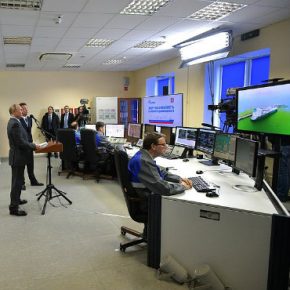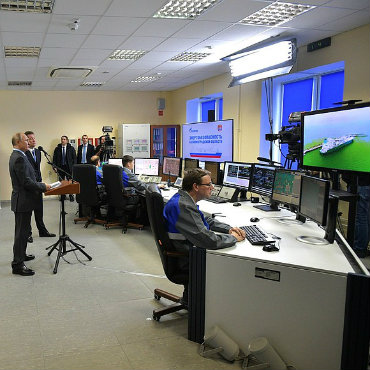Russia is too small to win the war in Ukraine
Category: Macroeconomics

LNG terminal, Kaliningrad, Russia(President of Russia, Public domain)
Russian state holding InterRAO launched the Pregolsky gas-powered station with a capacity of 455.2 megawatts (MW), the largest of four stations with a combined capacity of 1 gigawatt. The Mayakovskaya and Talakhovskaya plants, also gas powered, have a combined power of 312 MW. They came online last March, while the fourth, coal-powered Primorsky, could be completed in 2020, and will function as a backup.
„The region will become fully energy independent once the construction of the reserve Primorsky thermal power station is completed,” InterRAO cited its head, Boris Kovalchuk. The RUB100bn project is financed by state-owned holding company Rosneftegaz, which is funded by energy giants Gazprom and Rosneft.
Lithuania, along with fellow EU member states, Estonia and Latvia, intends to unplug itself from the Russian power grid and integrate into the EU grid by 2025.
Kaliningrad has relied on Lithuania, which in turn imports power from mainland Russia. Lithuania, Latvia and Estonia joined the EU in 2004, but their grids are still synchronized with Russia and Belarus. At present, the power systems of the Baltic States are tightly interconnected with Russian and Belarussian power systems with AC 330 kV lines. They import electricity produced in Russia, have access to the other countries’ power reserves, and participate in dispatch and regulation.
Lithuania, Latvia and Estonia have always considered their dependence on Moscow as a threat, a concern that has increased since the crisis in Ukraine. The three Baltic states now face the risk of heightened tension with Russia over its Kaliningrad exclave becoming isolated, and they need to secure a political deal with Poland. But Warsaw has been reluctant about building a LitPol link 2 with Lithuania, possibly because of high investments’ costs (ca. EUR300m from the Polish side), potential price competition from the electricity exported by Lithuania and concerns about the environmental impact.
To facilitate the process, the European Commission will enable the involved transmission system operator to apply for financial support from EU funds. „In a true Energy Union there is no room for energy islands and electricity has to be able to flow freely across borders,” said Miguel Arias Cañete, European Commissioner for Climate Action and Energy on the Nordbalt and Litpol links inauguration ceremony.
The critical phase was due late 2018, when Baltic states were set to begin testing unplugging themselves from the Russian grid, but those tests have been postponed and no new date agreed. Russia is to conduct its own test, by temporarily unplugging Kaliningrad from neighboring states, in May 2019.
Deputy Prime Minister Dmitry Kozak said the Baltics have told Russia they will conduct their test after Kaliningrad has conducted its own test.
On January 8, Gazprom put into operation an offshore gas receiving terminal and the Marshal Vasilevsky Floating Storage and Regasification Unit (FSRU) in the Kaliningrad Region. Lithuania has a contract with Gazprom on gas transit to Kaliningrad until 2025 and it has not been breached, Energy Minister Zygimantas Vaiciunas says.
„Kaliningrad is taking the same path Lithuania took 4 years ago, and is testing a similar LNG terminal to the one in Klaipeda. In fact, just the same way as Lithuania tested its own LNG terminal, natural gas imports from Russia were restricted. Its’ necessary technologically for such a terminal to be tested 100 per cent,” Vaiciunas told BNS Lithuania.
Earlier, Gazprom set up the Kaliningradskoye underground gas storage (UGS) facility and increased the throughput capacity of the Minsk-Vilnius-Kaunas-Kaliningrad gas pipeline, the only route for gas deliveries to Russia’s westernmost constituent entity until now.
The terminal and the FSRU allow up to 3.7 billion cubic meters (bcm) of gas to be delivered by sea on an annual basis. If necessary, the new facilities will meet the current and future needs of the Kaliningrad Region. “A unique project that has no equivalent in Russia, a sophisticated project of national importance is now completed,” Gazprom CEO Alexey Miller said. “The Kaliningrad Region has been provided with a totally independent gas supply route. Gazprom has brought the region’s energy security to a fundamentally new level. The Company will continue to work towards improving the reliability of gas supplies to the Kaliningrad Region,” he added.
Total investment in the project amounted to approximately EUR780m. The capacity of the floating terminal is 2.8 bcm, which is comparable with the current gas consumption in the whole Kaliningrad Region. To provide gas to the terminal, the South Korea-built Marshal Vasilevsky, special FSRU vessel (tanker) is used, which is able not only to transport LNG from the shipping terminals, but also to receive the so-called “dry stripped gas”, i.e. standard fuel suitable for storage in underground gas storages and use for its intended purpose.
Experts paid less attention to the geostrategic meaning the Marshal Vasilevsky FSRU, although in modern conditions the “mobilization” context of the event could not be overlooked. For example, the German Junge Welt newspaper wrote that Russia is trying to eliminate possible risks associated with the raw materials blockade of the Kaliningrad region.



